
Characiformes is an order of ray-finned fish, comprising the characins and their allies. Grouped in 18 recognized families, more than 2000 different species are described, including the well-known piranha and tetras.

Bubble nests, also called foam nests, are created by some fish and frog species as floating masses of bubbles blown with an oral secretion, saliva bubbles, and occasionally aquatic plants. Fish that build and guard bubble nests are known as aphrophils. Aphrophils include gouramis and the synbranchid eel Monopterus alba in Asia, Microctenopoma (Anabantidae), Polycentropsis (Nandidae), and Hepsetus odoe in Africa, and callichthyines and the electric eel in South America. Most, if not all, fish that construct floating bubble nests live in tropical, oxygen-depleted standing waters. Osphronemidae, containing the Bettas and Gouramies, are the most commonly recognized family of bubble nest makers, though some members of that family mouthbrood instead. The nests are constructed as a place for fertilized eggs to be deposited while incubating and guarded by one or both parents until the fry hatch.

Astatoreochromis is a small genus of haplochromine cichlids endemic to riverine habitats in East Africa. Tilapia bemini, usually placed in the tilapiines, may be rather close to this genus. However, extensive hybridization capabilities of African cichlids seriously confound analyses of phylogeny based on mtDNA, while morphological analyses tend to yield little information due to widespread parallel evolution.
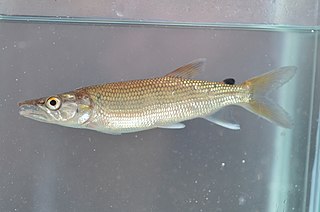
Hepsetus is a genus of African fishes, the African pikes or African pike characins, in the order Characiformes. It is the sole genus in the family Hepsetidae. It was long believed that only a single widespread species existed, H. odoe, but studies in 2011–2013 have shown that this species is restricted to parts of West and Central Africa. The well-known species of southern Africa, including Kafue River, is Hepsetus cuvieri. These predatory fish reach up to 44 cm (17 in) in length.

Haplochromis is a ray-finned fish genus in the family Cichlidae. It has been used as the default "wastebin taxon" for Pseudocrenilabrinae cichlids of the East African Rift, and as such became the "largest" fish "genus". Many of these cichlids are popular aquarium fishes; like similar Haplochromini they are known as "haplos", "happies" or "haps" among aquarium enthusiasts.

Hydrocynus is a genus of large characin fish in the family Alestidae commonly called "tigerfish," native to the African continent. The genus name is derived from Ancient Greek ὕδωρ ("water") + κύων ("dog"). The genus contains five species, all popularly known as "African tigerfish" for their fierce predatory behaviour and other characteristics that make them excellent game fish. Hydrocynus are normally piscivorous, but H. vittatus is proven to prey on birds in flight.

Brycinus is a genus of ray-finned fish in the family Alestiidae. Like other "African characids", they were formerly included in the Characidae but are actually somewhat more distantly related Characiformes.

Distichodus is a genus of freshwater fish in the family Distichodontidae found in Africa.

Marcusenius is a genus of the elephantfish group native to Africa. Its members are highly diverse in size, with the smallest species reaching less than 15 cm (6 in) and the largest more than 1 m (3.3 ft).
Rhabdalestes leleupi is a species of fish in the family Alestidae. It is found in Kenya and Tanzania. Its natural habitats are rivers and freshwater lakes.

The Cornish jack, Mormyrops anguilloides, is a species of weakly electric fish in the family Mormyridae, native to quiet waters in much of Sub-Saharan Africa. The largest species in its family, the Cornish jack is a nocturnal group hunter of smaller fishes, using electricity to locate its prey and communicate with other members of its group. It is a commercial game fish valued for its size and taste.
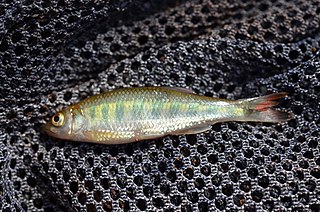
Raiamas senegalensis is a species of cyprinid fish in the genus Raiamas from western Africa east to the River Nile. It sometimes is found in the aquarium trade.
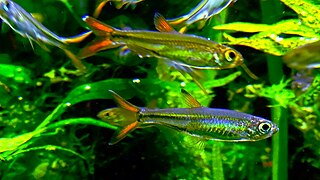
Ladigesia roloffi, the Sierra Leone dwarf characin, is a species of African tetra that is found in Sierra Leone and Liberia. It is the only member of its genus.

Cichlidogyrus is a genus of monopisthocotylean monogeneans in the family Ancyrocephalidae. The type-species of the genus is Cichlidogyrus arthracanthusPaperna, 1960, by original designation. All the species of the genus are parasites on the gills of fish, namely African Cichlidae, Nandidae and Cyprinodontidae.
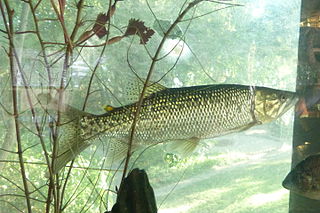
Hepsetus cuvieri, sometimes known as the African pike or Kafue pike characin, is a predatory freshwater fish found in southern Africa. This species was described in 1861 by the French naturalist Francis de Laporte de Castelnau.
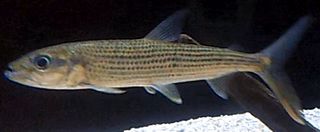
Hydrocynus forskahlii, the elongate tigerfish, is a species of predatory characin from the family Alestidae which is found in northern and western Africa.

Cichlidogyrus kmentovae is a species of monopisthocotylean monogenean in the family Dactylogyridae. It is a parasite of the gills of the fish Hemichromis stellifer of the lower Basin of River Congo.
The Itimbiri River is a right tributary of the Congo River, which it joins above Bumba. At one time it was important as a navigable waterway for transporting good from the northeast of the country down to the Congo.

The Tshopo River is a river in the Democratic Republic of the Congo. It flows through the north of the city of Kisangani and joins the Lindi River just before that river enters the Congo River. It gives its name to the province of Tshopo.
Nannopetersius mutambuei is a species of fish in the African tetra family, only found in the Inkisi River upstream of the Sanga dam in the lower Congo River basin, in the Democratic Republic of the Congo. This species reaches a length of 12.0 cm (4.7 in).


















